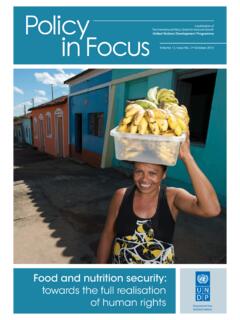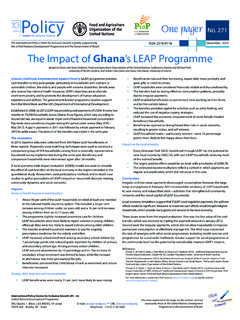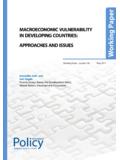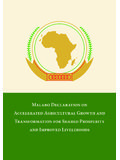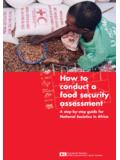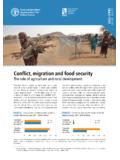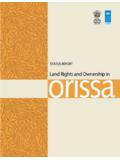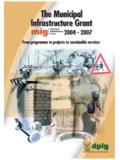Transcription of The Impacts of the Child Grants Programme in …
1 The views expressed in this page are the authors and not necessarily those of the United Nations Development Programme or the Government of : URL: Telephone: +55 61 2105 5000 International Policy Centre for Inclusive Growth (IPC - IG) United Nations Development ProgrammeSBS, Quadra 1, Bloco J, Ed. BNDES, 13 andar 70076-900 Brasilia, DF - BrazilThe International Policy Centre for Inclusive Growth is jointly supported by the United Nations Development Programme and the Government of 2318-9118No. 281 March, 2015 The Impacts of the Child Grants Programme in Lesothoby Benjamin Davis, Silvio Daidone and Joshua Dewbre, Food and Agriculture Organization of the United Nations; and Katia Covarrubias, Graduate Institute of International and Development StudiesLesotho s Child Grants Programme (CGP) provides cash transfers to reduce malnutrition, improve health and increase school enrolment among orphans and vulnerable children.
2 The Programme has undergone a major transformation since it started in 2009: funding has largely been taken over by the government, and the institutional and operational systems needed for a nationwide Programme are in place. Today, the CGP reaches nearly 20,000 households and 65,000 children across the time of baseline data collection in 2011, beneficiary households received a quarterly payment of Maloti (M) 360 (about USD36). In April 2013, the transfer was indexed to the number of children in each household, ranging from M360 for households with one to two children, to M600 (USD60) for households with three to four children and M750 (USD75) for households with five children or more. During the study period, payments were not always on schedule. The evaluationThe impact evaluation was based on a randomised control trial design, where a representative sample of CGP beneficiaries, together with a control group, were interviewed for a baseline survey in 2011 and for a follow-up in 2013.
3 A local economy-wide impact evaluation (LEWIE) model simulated Impacts on the local economy, combining households survey data with a business enterprise survey. Researchers collected information on beneficiaries perceptions of the Programme s impact on household decision-making, community dynamics and social networks. Finally, a costing study reviewed the historical costs of the CGP and assessed its affordability in the current fiscal environment. ImpactsIncreased spending on children The messaging of the Programme that the CGP funds should be used in the interest of children was strictly followed by beneficiary households. The CGP stimulated a large growth in school-related expenditures, including a 26 percentage point increase in the share of pupils (ages 6 19) with uniforms and shoes.
4 The impact was particularly pronounced for young boys and girls: from a base of M60 ( ), the CGP increased the amount spent on each student under 12 years during the school year to M83 ( ).Increase in birth registration and Child health The CGP increased birth registration a requirement of the Programme by 37 percentage points among children six years and under. While the study showed no real increase in the number of children who visited a health care provider, there was a 15 percentage point reduction in the proportion of boys and girls under five years suffering from illness prior to the survey. Increase in school enrolment The CGP increased the number of children enrolled in primary school, particularly teenage boys who might have otherwise dropped out. The Programme did not have any noticeable impact on other dimensions of school protection against food insecurity While food security continues to be a complex issue in Lesotho, the CGP reduced the number of months in which households experience extreme food shortages.
5 This meant food security gains for both adults and children. Nevertheless, the effects on food consumption and dietary diversity were concentrated around pay dates, possibly due to the unpredictability of on household livelihoods The CGP increased the purchase of crop inputs, such as pesticides, and boosted maize and vegetable production, likely due in part to a food grant in 2012 and 2013, as an emergency response to the poor harvest that affected food supply in Lesotho. Beneficiaries tended to reduce their involvement in paid labour and, overall, were more resilient to shocks and less prone to engage in disruptive risk-coping strategies. Impact on social networks The CGP strengthened informal sharing arrangements in the community, giving rise to cash and in-kind support both from and to beneficiary and non-beneficiary households.
6 The existence of strong reciprocity bonds increased self-esteem in CGP communities. Impact on the local economy The LEWIE model for the CGP found that the transfers had the potential to lead to relatively large income multipliers. Every Maloti transferred to poor households could raise local income by , with ineligible households receiving the bulk of the indirect benefit. If land and capital constraints limit the supply response, higher demand for local commodities may put upward pressure on prices, and the real income multiplier could be as low as Cost and affordability Assessments of current and future costs of the Programme suggest the CGP to be affordable under the current macroeconomic framework in the medium term (2014/15 2017/18) and with significantly less certainty about macroeconomic assumptions in the longer term.
7 The total cost of the Programme during its initial phase of implementation stood at M82 million between October 2007 and December 2012, of which 38 per cent was transferred to :Kardan, A., E. Sindou and L. Pellerano (2014). Lesotho Child Grants Programme : The historic and future costs of the CGP and its affordability. Commissioned by UNICEF for the Government of Lesotho. Oxford, Oxford Policy Policy Management (2013). Qualitative research and analyses of the economic impact of cash transfer programmes in sub-Saharan Africa. Lesotho Country Case Study Report, PtoP project report. Rome, Food and Agriculture Organization of the United , L., M. Moratti, M. Jakobsen, M. Bajgar and V. Barca (2014). Child Grants Programme impact evaluation: Follow-up impact report. Commissioned by UNICEF/Food and Agriculture Organization of the United Nations for the Government of Lesotho.
8 Oxford, Oxford Policy , E., K. Thome and M. Filipski (2014). Evaluating local general equilibrium Impacts of Lesotho s Child Grants Programme . PtoP project report. Rome, Food and Agriculture Organization of the United Nations and the World more information, contact the PtoP team at or visit the website < >.

